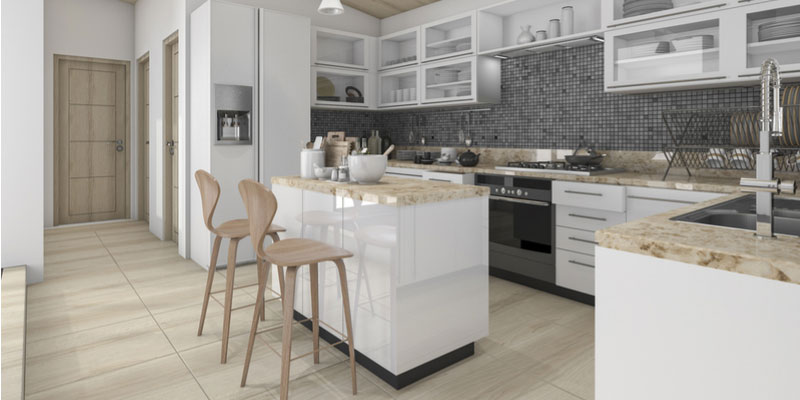Kitchen floor options offer a wide range of choices from laminate to hardwood, vinyl to bamboo, cork to concrete, and tile in three options. Today, the focus is on tile flooring one of the ideal choices for your kitchen floors. Not only is tile flooring beautiful and available in a vast selection of colors, styles, and shapes; tile flooring is durable, long-lasting, and both water and stain resistant. Kitchen floor tile also fits nearly every budget with prices ranging from $1 to $100 per square foot depending on your choice of porcelain, ceramic, or stone tile options.
Types of Kitchen Floor Tile
Understand, first, that ceramic tile and porcelain tile are similar in some ways. Both ceramic and porcelain are made from specific clay mixtures which are then fired at high temperatures. The result is a hard, durable tile that can be glazed or unglazed. And that is where the similarities end.
- Ceramic Floor Tiles – Ceramic floor tiles, are also known as “non-porcelain” floor tiles to encourage the distinction between the two tiles. Though both are hard tiles, ceramic is the softer of the two. Ceramic is more porous, but glazing creates a hard-wearing surface that is stain, spill, and splash resistant. Ceramic tile comes in a wide range of colors and styles making it a favorite of kitchen designers everywhere. Ceramic tile is softer than porcelain making it easier to cut and install in unique ways. With all these positives, ceramic tile is not everyone’s favorite because it is hard on the feet and its grout lines require ongoing care to maintain the beauty of the floor.
- Porcelain Floor Tiles – Porcelain floor tiles are made with the addition of sand to the clay mixture. The firing process applies heat and pressure to create a denser, harder, less porous tile compared to ceramic tile. Porcelain tiles are the ideal choice for kitchens, bathrooms, and other high-traffic areas, including outside. Unglazed porcelain’s color is achieved by adding it to the clay mixture ensuring the color and pattern is carried throughout the tile. Glazed porcelain utilizes a glass-like coating during the firing process to create any color. Porcelain tile is more difficult to cut and install than ceramic tile, requiring special tools for installation. The American’s with Disabilities Act (ADA) has certified select specialty porcelain kitchen floor tiles as slip-resistant, another positive for porcelain tiles which are already and optimal choice for kitchens.
- Stone Floor Tiles – Stone floor tiles are tiles made from natural stone including granite, slate, travertine, marble, and limestone. Generally stone tiles need to be sealed every two or three years because they are porous. Stone tiles are available polished, which highlight the stones beauty but are slippery when wet, or honed, which are less slippery and less vivid.
- Granite – One of the hardest flooring tiles, granite is resistant to stains and scratches.
- Slate – Formed in layers, slate splits into thin sheets which are cut into tiles and are left rough or honed.
- Travertine – One of the softer stone tiles, travertine comes in a wide range of colors. Travertine is sensitive to acidic liquids and can easily stain.
- Marble – Marble is the oldest of stone tile flooring and comes in a number of colors, but is prone to scratches and stains.
- Limestone – A bit harder than travertine, limestone offers incredible grain patterns for a unique look.
Kitchen Floor Tiles, while beautiful and durable, have some drawbacks as well. Tile’s strength and durability also means dropped breakables will break and long hours in the kitchen can cause fatigue. Tile also reflects every sound, so can make your kitchen even more noisy. Adding area rugs and anti-fatigue mats can help. Though ceramic tile itself requires little maintenance, the grout does.
Overall, floor tiles offer a great option for your kitchen floors, allowing you many options, styles, and colors to meet your needs.

